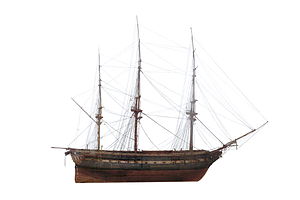In England, there was a good deal of schadenfreude accompanying the outrage following the sensational wreck of the Medusa. The French in command of a French frigate–the best possible combination for maritime incompetence, they said, Even the masterful painting of the drifting raft of desperate survivors received tumultuous applause in London because Monsieur Gericault’s effort was:
“of the utmost difficulty, and with a singular absence of the national vanity ascribed to his countrymen, one which it would be well for the naval character for France to have blotted from her maritime annals.” — the Globe (1820)
Had British seamen been at her helm, such a disaster might have been diverted. Unless one happens to be sailing in a place known as “The Dangerous Area.”
Off the southern coast of present-day Sri Lanka lie two great coral reefs and accompanying rocks called the Great and the Little Basses. Unlike the Arguin Bank that the Medusa foundered upon, these formations along Ceylon’s shores, as it was known in those days, were well-documented and mapped. Yet time and again, ships fell victim to their deadly projections.
Some believed it was the haze that lay over the water, so that:
“..even in the day time those excellent landmarks along the shore, which, if, discernible, afford an infallible guide, cannot occasionally be distinguished when close to the Basses.” — The Nautical Magazine (1848)
But that didn’t account for the number of wrecks that occurred at nighttime, and to ships that were well out to sea. Or, so they thought.
On several occasions, from 1792 to 1804, English ships believed to be well away from the treacherous reefs would suddenly find themselves during the night observing breakers, the signal they were among the rocks. It was as if the alien shore had lured their vessels toward danger like the Sirens of old.
The Corona was a forty-gun frigate of the Hortense class, built for the French Navy. Like her sister ship the Caroline, she had been captured by the British Navy during the Napoleonic Wars. Corona’s decks were covered with the blood of her dead captain and 200 of her crew before she was set ablaze by her captors. Pulled to Malta, she was repaired and renamed the Daedalus, now in the Prince Regent’s service.
She was given to the command of Captain Murray Maxwell, grandson of the Second Baronet of Monreith. She nearly ruined his naval career.
Daedalus was escorting East India Company ships Atlas and Bridgewater to China. Ceylon, now known as Sri Lanka, is the gateway to the South China Sea. Captains knew to pass by its coast well to the south and avoid the reefs there altogether. Yet somehow, by morning, to everyone’s surprise and alarm, it was discovered the ships were among the Basses: 
“..the Atlas grazed outside the Little Basses, and soon after that the Daedalus struck on a reef within the Basses, and the Bridgewater, close on the starboard side of the frigate, grazed over the same reef, but she bore away and passed between the Little and the Great Basses as did the rest of the fleet…” —The Nautical Magazine (1848)
Daedalus was doomed. To haul her off the reef would sink her faster than leaving her where she was. Almost to the minute that everyone was evacuated, she keeled over and sank.
Later, it was discovered that strong underwater currents exist all along the southern coast of Ceylon, capable of hauling even a British frigate to places it never intended to go. Because these conditions seems to be especially strong at night, the British government eventually installed two lighthouses to warn ships of their proximity to “The Dangerous Area.”


Wonderful, informative post! Tweeted
LikeLike
thanks, Nancy–your nautical profile goes with the post!
LikeLike
Good decision to abandon her. Great post, Angelyn!! Tweeted and shared on FB.
LikeLike
Yes–I believe his conduct was later criticized for the position of the Daedalus when she ran aground. More on that next post. By the way, saw a lovely profile of your Anna book in the Kensington handout we received today at a chapter meeting.
LikeLike
Wonderful post! Love historical maritime information!
LikeLike
Austen’s Persuasion is verily haunted by the sea and the men who sail upon it. Everything nautical for me, these days. Thanks for stopping by!
LikeLike
Fascinating info! I tweeted and shared.
LikeLike
I’m so glad you liked it–and appreciate your sharing this post with others!
LikeLike
What an interesting post, Angelyn. Great information!
LikeLike
Hello, Barbara–so nice to see you!
LikeLike
Pingback: Regency Wrecks: Voyage to Paradise (Part One) | Angelyn's Blog